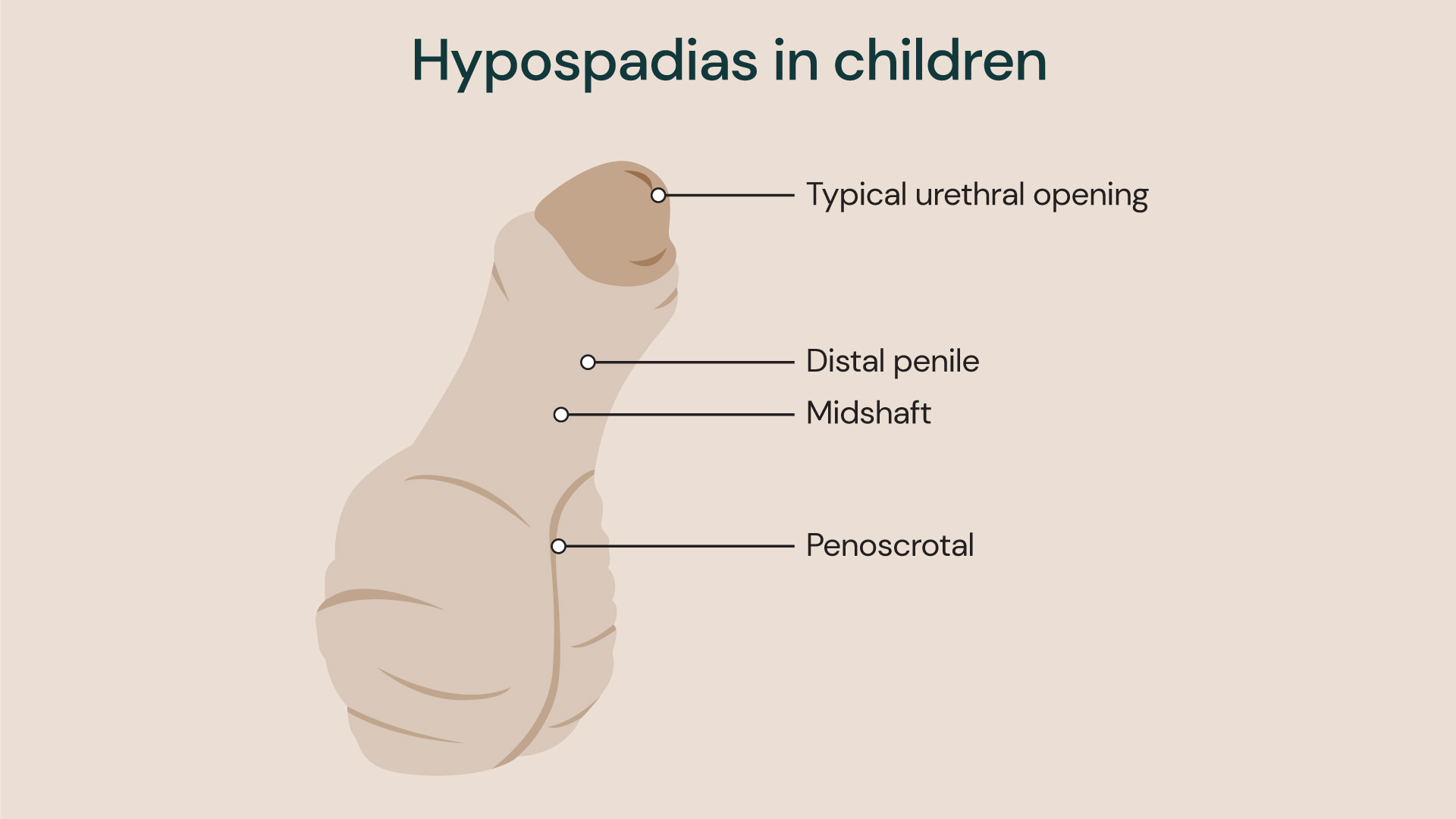Hypospadias is a congenital condition (present from birth) that affects the urethra development in a child’s penis. It is a fairly common birth defect, estimated to impact around 1 in every 200 babies.
Although hypospadias is common, it can be worrying for a parent. Learning more about hypospadias — including what it looks like, the causes and how it can be treated — can help.
What is hypospadias?
Hypospadias occurs when the opening of the urethra (the tube that carries urine from the bladder to the outside of the body) isn’t located at the tip of the penis.
The urethra normally forms early in foetal development at around 8–14 weeks gestation. However, in babies with hypospadias, the opening of the urethra forms anywhere from just below the end of the penis to the scrotum.
This can make urinating more complex and also cause the penis to develop a hooded appearance because only the top half of the penis is covered by the foreskin.
Types of hypospadias
Hypospadias is split into 3 different types. The variety that your child is diagnosed with will depend on the location of the opening of the urethra. These types are:
Distal – Where the opening of the urethra is located on or near the head of the penis, but not on the tip.
Midshaft – The opening of the urethra is located along the shaft of the penis.
Penoscrotal – Characterised by a urethra opening located where the penis and scrotum meet.
Your paediatric urologist will be able to tell you which type your child has after the examination.

Hypospadias is split into three different types.
Hypospadias symptoms in children
Checking for hypospadias is usually part of the routine examination of babies after they are born. However, other signs and symptoms of hypospadias include:
- visible opening of the urethra in a location other than the very tip of the penis
- downward curve of the penis
- hooded appearance of the penis due to only the top half of the penis being covered by foreskin
- abnormal spraying during urination
In some instances, it’s possible to detect severe hypospadias before your baby is born during an ultrasound. However, it is much more likely to be noticed during the physical examination of your baby after birth.
What causes hypospadias?
Hypospadias is a congenital condition, which means that it is present at birth and happens during foetal development. The reason why some children develop hypospadias and others don’t is normally unclear.
However, some factors are believed to increase the risk of a baby being born with the condition. These include:
- a family history of hypospadias
- specific genetics that disrupt the hormones responsible for the formation of a penis
- pregnancy in those considered obese
- pregnancy in those over the age of 35
- taking certain hormones just before or during pregnancy
Hypospadias complications
There are several different complications associated with hypospadias. The most obvious is problems with urinating. When the opening isn’t located at the end of the penis, it can be much harder to control the direction of urine flow.
If not corrected this can lead to abnormal spraying of urine, and many children with uncorrected hypospadias find it easier to sit down to urinate.
Children with hypospadias can sometimes experience an abnormally curved penis, and a small percentage also experience undescended testicles, where the testicles do not drop into the scrotum shortly after birth.
Issues with impaired ejaculation direction can also occur in adulthood. Abnormal curvature of the penis and impaired ejaculation can cause problems with sexual intercourse and fertility.
Diagnosing hypospadias
Our paediatric urology specialists can diagnose hypospadias by a physical exam of your child’s penis.
Hypospadias repair
Not all hypospadias requires surgical correction. If the hypospadias is very minor, it may be possible to live with it without any functional problem, meaning that surgery isn’t necessary.
For those children with more prominent cases of hypospadias, the majority of parents choose to correct the condition with surgery to prevent future issues. This is usually performed when your child is beyond 12 months old.
Hypospadias surgery is usually carried out on as a day patient procedure and performed under general anaesthetic. In addition to repositioning the urethral opening, surgery may also be used to straighten the shaft of the penis. Depending on the severity of hypospadias, it is not always necessary to reposition the urethral opening and the foreskin appearance could be corrected either by circumcision or foreskin reconstruction as per parental choices.
If the urethral opening is near the base of the penis, it may be necessary to use tissue grafts taken from either the foreskin or the inside of your child’s mouth to reconstruct the urinary channel.
Locations
Our specialists can offer treatment for hypospadias in the following locations:
Discover our children's urology experts
When it comes to the health of your child, you want the reassurance that their care will be handled by the very best healthcare professionals. We offer a calm, comforting environment, where we put your child first while delivering the very highest levels of clinical excellence, quality and care.